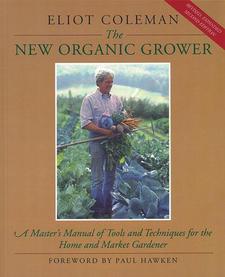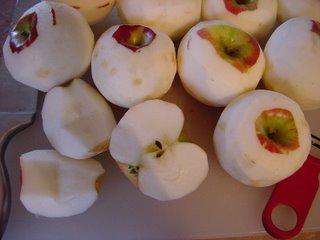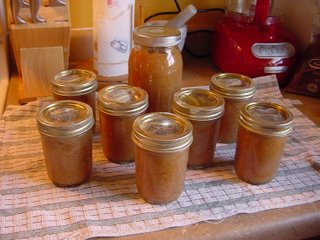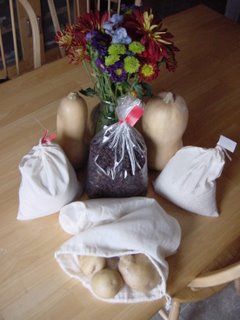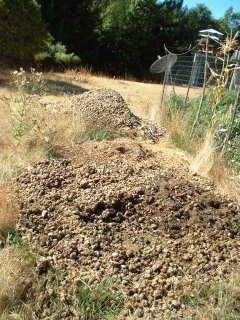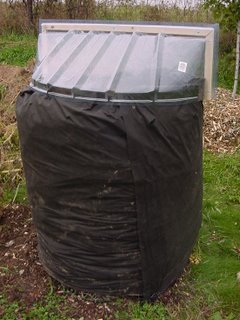It was an amazing day. So many of the community came out for it. The Willits Economic LocaLization (WELL) group did a very wise thing to link up with the The Grange.
The Grange is a Rural family fraternity founded in 1867, the nation's oldest general farm organization. From linking up with them, we "counterculture" sorts, as if believing that we have to be in better relationship with the planet and how we grow our food and where we get our energy is "counter to the culture", have this pool of amazing elders, some centurians, that participate in our events, share their wisdom and tell their stories of what it was like here back in their youth.

The event was held at our local Grange. There was a lot to see and do. There was a solar oven cookoff. This was my favorite solar oven. I got all sorts of written material that is still in my bag, but I am going to build a solar oven. They are so very simple! You can sterilize canning jars in them, cook stews and casseroles and soups, roast things, etc, all with the power of reflective material, glass and the sun.

This is Dave, the owner of Sanhedrin Nursery. He specializes in fruit trees and is a wealth of information about what grows well here in our little part of the world. He's also a pruning master who gives a free fruit tree pruning workshop every year at pruning time. When I stopped to talk to him, he gave me many contacts of local permaculturists who are sharing seeds of food crops that are both native to here and acclimated over many generations to grow well in our climate. He also gave me a flyer about Mendocino Permaculture's 25th Annual Chestnut Gathering and Potluck in early November. The Zeni Ranch has 100 year old, dry-farmed chestnut trees that are a testament to the sustainability of tree crops. The community is invited to come pick our own chestnuts from freshly fallen nuts, have a potluck and attend a discussion on growing the best nuts and fruits for our local climate.
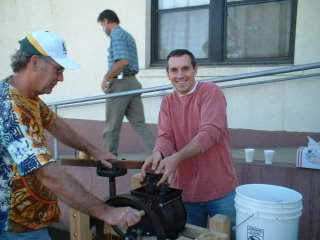
Dr. Jason Bradford is the founder of WELL. Here he is with his hand cranked juice press, pressing grapes and apples. They pressed fruit all day and the resulting juice was served in pitchers with our lovely dinner. Jason lives on a large ranch and actually grew wheat and milled it into flour. It was his wheat that I used in my main course dish. I didn't know that until yesterday.
Watching the demonstrations, which included the solar cooking, the juice pressing and food dehydration and an acorn workshop illustrated to me again, on a larger scale than I employ myself, how much work it takes to process food from its original state, or in the case of acorns,
transform something that is inedible into something rather deliciously edible.
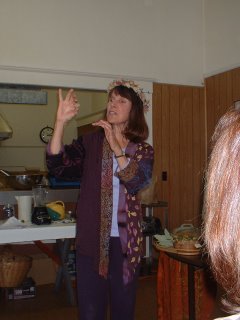 The Acorn Workshop:
The Acorn Workshop: Donna D'Terra is our local Grandma Herbalist here in Willits. She lives on a 160 acre piece of land that she has had for over 20 years. Her land is studded with majestic white oaks. About 7 years ago, she learned from the local Indian elder women how to collect, process, prepare and give thanks for the mighty acorn.
Yesterday I had said how hard I thought it would be to be vegan if you could only eat locally. I hadn't taken wild food into account. The acorn is a rich source of both fat and protein. They store well and you can put the meal into anything. You can grind it into flour that can be used for baking, although best used mixed with other flours. Click on this link for
acorn nutritional analysis, if you're interested.
I also learned that the native people here, the Pomos tended the oak forests by planting the acorns and tended the land here on a huge scale, creating a garden so large that it was beyond the comprehension scope of the white (un)settlers who came here 200 or so years ago. The Indian's whole world was a garden of theirs and the earth's co-creation. And the acorn was a large part of their sustanance.

There are three main types of oaks. Donna, Freddie and I are demonstrating each type with acorn caps and oak leaf branches. Donna was the tan oak. Freddie and I were the black and the white oaks, but I can't remember which one was whom.
The acorns are gathered in September and October, piled into baskets and dried out of strong light and away from moisture. Once they are dry, the meats are removed from the shells. Unlike the Native people who used mortar and pestles to crack and grind the acorns, we cracked them with hammers and zipped the meats up in a blender with water. The resulting mash is put in jars, filled 1/3 of the way with
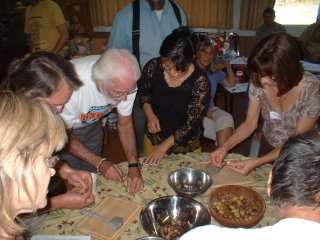
meal and then the rest of the way with water. This is stored in the refrigerator and the water is poured off every day and replaced with fresh. This process goes on for about a week and is how the tannins, which make the acorn inedible in its whole state, are leached off.
After about a week, the meal should taste just a little bitter and somewhat nutty. Then it is ready to eat. It can be cooked as a hot cereal, pretty much like any other hot cereal. It can be added to stews and soups. Donna said when you add it to things, it just disappears, but you get the nutritional benefits of it in whatever you add it to. You can also dry the resulting meal and grind it into acorn flour. This picture is of a group of us cracking already dried acorns.
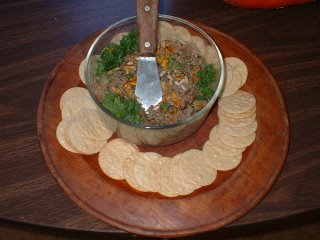
Donna also generously fed us acorn pate, made with olive, onions and celery. She also brought a small jar of just plain, ready to eat acorn much. It was rather bland, and very edible. Tara and I both said, "I could eat this," and have a plan to go up to a friend's land and start collecting acorns today.
This is Anne Weller, one of the organizers of the
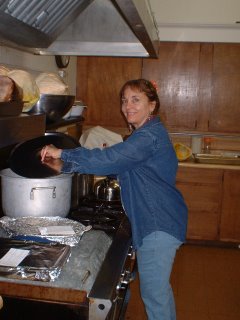
event. She did a fantastic job visioning and coordinating this amazing dinner that we had. She also built the lovely altar and led a heartfelt blessing of our food before we sat down to eat.
My heart was full when this entire room of my community joined hands, circling the the room and the food tables to give gratitude for our amazing bounty that our own lands give us. Annie sang a song and then we broke into lines to serve ourselves from the food tables. I will try to recount all the things that were there, but I'm quite sure I'm forgetting things.
There were 4 soups: A butternut squash, a pumpkin, a vegan vegetable and a chicken vegetable. There were gallons and gallons of salad made with local cherry tomatoes, peppers and lettuces, dressed with a tomato, herb, olive oil dressing. Trays of local sliced tomatoes and basil, fresh breads from the local bakery (not local grains, however), locally and freshly churned butter for the bread graced the salad table.
For the main dishes there were casseroles of many types: tomato, corn zucchini pie, eggplant parmesan (both having been topped with local sharp goat cheese instead of the traditional parmesan), a potato chard casserole, chicken vegetable stew and several potato casseroles with melted cheese, some with ham too. There were these amazing winter squash croquettes that I think were my favorite thing on the table. There was corned beef, ham and 2 1/2 foot long zucchinis that were stuffed with meat and vegetables. I know there was more, but this is all I can recall. It was too crowded at serving time to take pictures of the food, so I encourage you to let your imagination run here. For dessert there were bowls of fresh raspberries and fresh whipped cream, apple crumbles and my pumpkin custard.
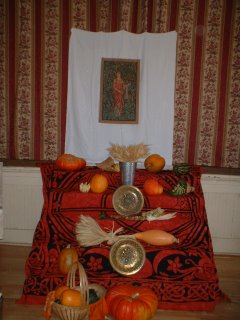
All in all, we fed close to 100 people and everyone had plenty to eat. I felt so well nourished by the entire day. It is good to see what is possible with a vision, some hard work and a community that shares the vision. For that I give great gratitudes.
Blessings on the harvest!
 So I have officially kicked off the 2007 gardening season! Here in far northern Zone 5 planting outside on March 1 is new to me. But using the successful coldframe design of 2006 I trudged through the 2' drifts to my gardens, scratched two rows into the pleasantly warm and moist soil and planted 20 mache plants.
So I have officially kicked off the 2007 gardening season! Here in far northern Zone 5 planting outside on March 1 is new to me. But using the successful coldframe design of 2006 I trudged through the 2' drifts to my gardens, scratched two rows into the pleasantly warm and moist soil and planted 20 mache plants.














